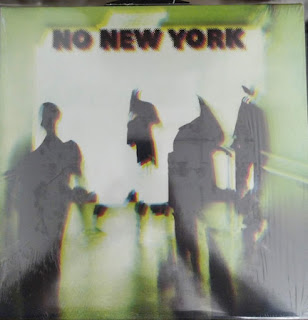Various - No New York (Album Review)
Various - No New York
(1978)
My copy: 2020 repress by Lilith.
Upon visiting New York to record with the Talking Heads, Brian Eno was so taken by the local no wave scene that he assembled four bands on short notice and produced this compilation as a pseudo-live snapshot of the movement. The production is uncharacteristically unmanipulated here, reinforcing Eno’s desire to capture the raw and brutal qualities of these four important acts.
The first four songs come from perhaps the most famous no waver James Chance and his similarly enigmatic backing crew the Contortions. Setting off with a less structurally experimental style, the Contortions lay in with the bulldozing bass of “Dish It Out,” expressing their distinct taste for funk and jazz. Despite Chance’s frantic yelping and the chaotic bending of the lead guitar, these are easily the most traditionally musical songs of the record, with “Flip Your Face” even mellowing the rhythm guitar out to sedated chords among strobing atonal keys. “Jaded” is a slow, brimstone-lit piece of jazz-gone-evil, with Chance’s saxophone playing in its most comprehensible form yet. Finally, the Contortions lay into their classic “I Can’t Stand Myself,” which owes most of its effectiveness to Don Christensen’s drumming.
Sitting at a likely intentional contrast to the Contortions is Teenage Jesus And The Jerks: with simple, rudimentary instrumentals that serve more as dramatic backdrops for Lydia Lunch’s poems. The slow rocking music of “Burning Rubber” frequently derails to slam in unison with Lunch’s words, her delivery exasperated and bewildered. The next three songs also continue with incredibly simplistic performances, instead focusing more on the relationship between silence and noise with frequent stops and starts around the vocals. Most notable here is the chainsaw bass tones of “Red Alert.”
Next is “Helen Fordsdale” from Mars, which reinvigorates the record with totally alien guitar sounds achieved through a combination of rapid, muted strumming and dashes of reverb applied by Eno. The result is an aptly described “helicopter blade” tone that oscillates alongside unending drum tension and foreign vocal nonsense. “Hairwaves” is lethargic with dejected guitar noodling, babbled vocals and an atmosphere that trudges along as if it were unknowingly drugged. Tension remains the theme in the cavernous tremolo of “Tunnel” as vocals duel with bass melodies on “Puerto Rican Ghost.”
The final four tracks come from Arto Lindsay’s D.N.A., kicking off with the refreshing key-accented blues shuffle of “Egomaniac’s Kiss.” The gravelly agonizing of the vocals are more reminiscent of heavier bands, though instrumentals like “Lionel” opt to construct rattling loops for guitar and electronic organ that wind up far more interesting without vocals. “Not Moving” really emphasizes the textural importance of the electronics as they add just the right dash of color to an almost entirely dark-and-gloomy-sounding record. Finally, "Size" rattles and rolls with a four-on-the-floor bass drum that helps to deconstruct the sort of dance/rock fusion that had been popular at the time.
It is only expected that someone like Eno would immediately recognize the fleeting importance of a movement such as no wave - and though it’s missing core contributors such as Glenn Branca or the Gynecologists, this compilation is a fantastic snapshot of one of New York’s most interesting cultural bubbles. Whether it be Chance’s desperate combination of funk and unconventional rock, the grim atmosphere of Lunch’s thoughts, the drooling eccentricity of Mars or the whirlwind textures of D.N.A., it is certain that these four artists stood at the forefront of a crucial time for experimental music.




Comments
Post a Comment